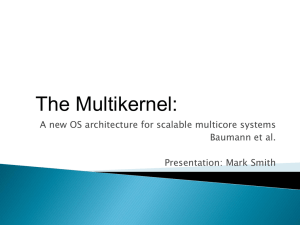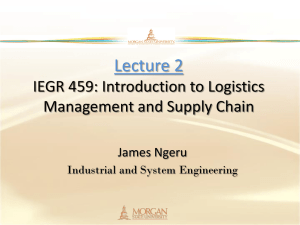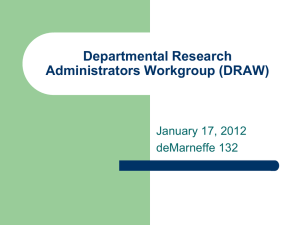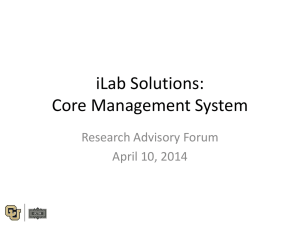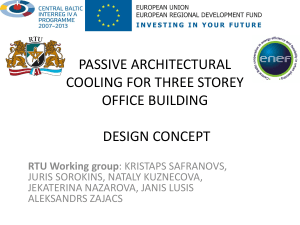pptx - Parallel Programming Laboratory
advertisement
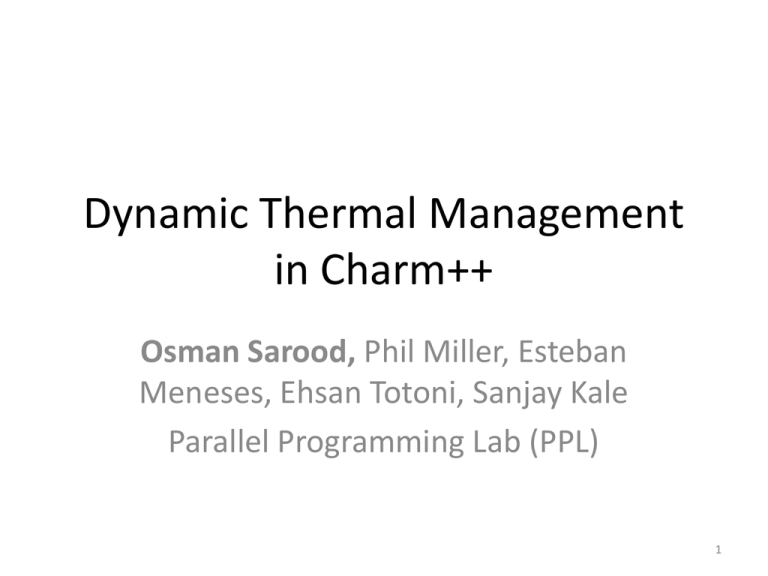
Dynamic Thermal Management in Charm++ Osman Sarood, Phil Miller, Esteban Meneses, Ehsan Totoni, Sanjay Kale Parallel Programming Lab (PPL) 1 Why care about energy? • Data centers consume 2% of US Energy Budget in 2010[1] • Cost $5.1 billion consumed 77 billion KWh • Energy bill per annum[2]: – Sequoia: $4.47M – Blue waters: $5 M – K computer: $7.4M 1. Growth in data center electricity use 2005 to 2010, Jonathan Koomey 2. Based on 7 cent/Kwh 2 Why Cooling? • Cooling accounts for 40-50% of total cost • Average PUE ratio was 1.8 in 2011 • Most data centers face hot spots responsible for lower temperatures in machine rooms • Data center managers can save*: – 4% (7%) for every degree F (C) – 50% going from 68F(20C )to 80F(26.6C) *according to Mark Monroe of Sun Microsystem 3 Need for thermal management • High core temperatures can increase: – Cooling energy consumption – (1st part) – Failure rate since it doubles for every 10C increase in temperature – (2nd part) – Machine machine energy consumption – (in progress) 4 1st Part: Reducing cooling energy consumption using thermal constraints 5 Core Temperatures *CRAC stands for Computer Room Air Conditioning • Running Wave2D on 128 cores: • Temperature measurements after every second • Average temperature goes from 32C to 52C • Hottest core ends up 9C above the average 6 Core Temperatures Hotspot! • Reducing cooling results: – increase of 6C in average temperature i.e. 58C – With reduced cooling (CRAC set-point 25.6) hottest core is 20C above average core temperature 7 Dynamic Voltage and Frequency Scaling (DVFS) • changing processor frequency/voltage to save power • used cpufreq module from linux to change frequency/voltage pairs 8 Processor Timelines for 2 iterations of Wave2D Idle Time w/o TempLDB • Shows processor utilization during execution time (green & pink correspond to computations, white is idle time) • One core can cause timing penalty/slowdown! 9 Charm++ to the rescue! • Object-based over-decomposition – Helpful for refinement load balancing • Migratable objects – Mandatory for our scheme to work – supports fault tolerance • Time logging for all objects – Central to load balancing decisions • Supports plugin load balancer • Production-quality system used by many applications • For more info, see http://charm.cs.illinois.edu/why/ 10 Temperature Aware Load Balancer • Specify temperature range and sampling interval • Runtime system periodically checks core temperatures • Scale down/up frequency (by one level) if temperature exceeds/below maximum threshold at each decision time • Transfer tasks from slow cores to faster ones • See ‘‘Cool’ Load Balancing for HPC Data Centers’, IEEE Transactions on computers for details 11 Experimental Setup • 128 cores (32 nodes), 10 different frequency levels (1.2GHz – 2.4GHz) • Direct power measurement • Dedicated CRAC • Power estimation based on Pac = f ac *c air *(Thot + Tac ) • Applications: Jacobi2D, Mol3D, and Wave2D – Different power profiles • Temperature range: 47C-49C 12 Average Core Temperatures in Check CRAC set-point = 25.6C Temperature range: 47C-49C • Avg. core temperature within 2 C range • Can handle applications having different temperature gradients 13 Hotspot Avoidance • Maximum Difference without our scheme (w/o TempLDB) – Increases over time – Increases with CRAC set point • Maximum Difference with our scheme (TempLDB) – Decreases with time – Insensitive to CRAC set point 14 Timing Penalty • Decrease in cooling, increases: – Timing penalty – Advantage of our scheme 15 Processor Timelines for Wave2D w/o TempLB TempLB 16 Machine Energy Consumption • High base power coupled with timing penalty doesn’t allow machine energy savings. 17 Cooling Energy Consumption • Our scheme saves up to 57% (better than w/o TempLDB) due to smaller timing penalty 18 Related Publications • Osman Sarood, Laxmikant Kale, A `Cool’ Load Balancer for Parallel Applications, SC 11 • Osman Sarood, Phil Miller, Ehsan Totoni, Laxmikant Kale, `Cool’ Load Balancing for High Performance Computing Data Centers, IEEE Transactions of Computers 19 2nd Part: Improving Reliability using Thermal Constraints 20 Temperature and Mean Time to Failure (MTBF) • MTBF halves (failure rate doubles) for every 10C increase in temperature • MTBF (M) can be modeled as where ‘A’ and ‘b’ are constants and ‘T’ is the temperature 21 Core temperatures and MTBF Temperature histogram Wave2D on 128 cores (blue – cool cores, orange – hot cores) 22 Removing the hot spot Remove hot spot: Avg. of hot cores = Avg. of cool cores Generate random temperature values for hot cores and calculate ‘M’ 23 Constraining core temperature to lower values Remove hot spot: Avg. of hot cores = Avg. of cool cores Generate random temperature values for all the cores and calculate ‘M’ 24 Core temperature-MTBF relation 25 Core temperature-MTBF relation Experimental data 26 What did we learn? • By constraining core temperatures one can select an MTBF (within a range) • Execution time (slowdown) penalty associated with selecting the MTBF • Each application can give rise to a different MTBF for the cluster due to temperature variations 27 Benefits? Is the decrease in MTBF good enough to reduce total execution time given the slowdown associated inusing DVFS? 28 Performance model Symbol Meaning T Total execution time W Useful work τ Check pointing period δ Check pointing time R Restart time μ slowdown 29 Strategy • Combine temperature control with fault tolerance • Migrateable objects key for reducing DVFS associated slowdown 30 Improved temperature aware load balancing • Communication friendly load balancing: – Instead of randomly picking a task to migrate to any overloaded processor, migrate a task that communicates the most with a given underloaded processor – Always try to converge to the initial mapping – Select ‘foreign’ task to migrate before ‘home’ tasks 31 Experimental setup • Ran experiments on a 128-core cluster (no simulations) to see the prediction of the model • Scaled down M: 4 hours • Introduced random faults based on exponential distribution with a mean of ‘M’ • Three applications – Jacobi2D: 5-point stencil application – Lulesh: Unstructured Lagrangian Explicit Shock Hydrodynamics application developed @ LLNL – Wave2D: finite difference for pressure propagation 32 Experimental setup • Baseline for each application: – Run without temperature control – ‘M’ calculated using the actual temperature values we get without temperature constraint – `τ’ calculated using Daly’s formula: • Temperature constrained experiment: – `M’ calculated using the max allowed temperature – `τ’ calculated using Daly’s formula 33 Reduction in execution time • Each experiment was longer than 1 hour having at least 40 faults • Model closely matches the experiments 34 Savings in machine energy consumption Actual measurements based on power meters installed in the PDUs 35 Prediction for larger machines Improvement in MTBF MTBF/socket: 20 years, checkpointing time (δ): 240 secs 36 Future work • Evaluating benefits of thermal control for message logging and parallel recovery • Scheduling jobs for a data center under a fixed thermal and/or power budget • Reducing frequency for least sensitive parts of code to reduce slowdown for TempLDB 37 Hot spot in Blue Waters? This shows a possibility of Inter-row hot spot. There might be Intra-row hot spots! The readings showing cold water temperature for each row Row 1 63F 62F 63F 63F 63F 64F 65F 65F 68F 68F 69F 69F Row 7 70F 69F 38 Acknowledgements • We are thankful to Prof. Tarek Abdelzaher for using tarekc cluster 39 Questions 40 Optimum points for applications • Jacobi2D gets the max benefit • Different optimum temperature thresholds along with maximum benefits 41 Reason for different optimum temperature thresholds A move to the left (decrease in temperature threshold): • Increases reliability (gain) • Increases the slowdown due to temperature control (cost) 42 Prediction for larger machines Proposed Exascale machine in ‘ExaScale Computing Study’ by Peter Kogge has an incredibly low Memory/FLOPS ratio Temperature threshold of 46C 43 Machine Energy • Accounts for 50%-60% of total cost • Earlier work: – A `Cool’ Balancer for Parallel Applications (SC11) concentrated on saving cooling energy – `Cool’ Load balancing for HPC Data Centers (IEEE Transactions on Computers Sept 2012) extended our work and its usefulness with MPI applications – limited machine energy savings • Is it possible to reduce execution time penalty and machine energy while reducing cooling energy? 44 Execution Blocks for iterative applications • Divide each iteration into Execution blocks (EBs) – different sections based on sensitivity to frequency – Manually done using HW performance counters • Profile each EB for different frequency levels – Wall clock time (system clock) – Core power consumption (fast onchip MSRs) 45 Execution Blocks (EBs) (NPB-IS) EB2 wastes a lot of energy while running at max frequency! EB1 much more sensitive to frequency with the same power as EB2 46 EBTuner • Profile each EB for all frequency values – Can be completed in milliseconds using energy MSRs of Sandy Bridge • Periodic sampling of core temperatures – Temperature > Threshold • Decrease frequency one notch for EB that results in minimum timing penalty – Temperature < Threshold • Increase frequency one notch for EB that results in maximum time reduction 47 Timing penalty Increase in execution time compared to runs with no temperature control and all cores working at maximum possible frequency 48 Reduction in machine energy 49 Work in progress • Extend the work to multiple nodes. – Use Charm++ since load balancing would be necessary – Solution for the incapability of present day chips to apply DVFS to individual cores 50 Timing Penalty/ Total Energy Savings Normalization w.r.t all cores running at maximum frequency without temperature control • Our scheme brings green line to red line – Moving left: saving total energy – Moving down: saving execution time penalty • Slope: timing penalty (secs) per joule of energy saved 51

